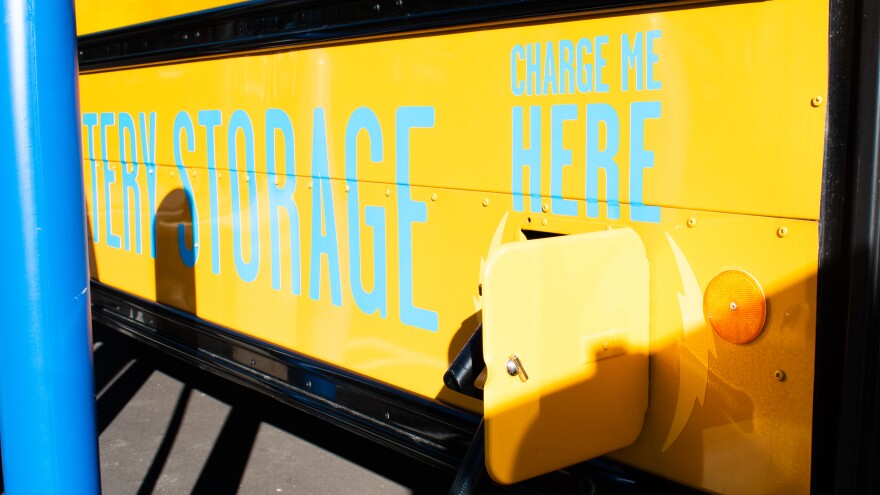As more commercial vehicles switch to electric batteries, the demand for EV charging stations that big trucks can use increases. Duke Energy plans to explore how solar power and battery storage can help meet that need at a new commercial-scale EV charging station west of Charlotte.
Duke Energy's microgrid at its Emerging Technology Center in Mt. Holly includes a solar farm and two battery storage systems under construction. The company plans to commission one battery this week. Once it’s finished, it will connect to a new electric vehicle charging station at the center. It’s part of a larger initiative to test different applications of microgrids.

Duke partnered with Electrada to operate this charging station. Electrada's Jenn Fiegel demonstrated by inserting one into the port of an electric semi-truck, where it locked in place.
“What they’re doing right now is they’re talking to each other — doing a handshake — making sure they’re safe on both sides, so you can safely start passing electricity,” Fiegel said.
The lock is an extra safety measure since the truck is drawing 132 kilowatts of power from the grid. That’s like 15 homes suddenly coming online, said Jay Oliver, managing director of grid systems integration at Duke Energy.
“A lot of power that goes into these vehicles,” Oliver said. “That’s what we need to prepare for is how to best deal with that.”
Instead of paying by the gallons, these vehicles pay by the kilowatt hour. The semi-truck’s battery can hold 438 kilowatt-hours of energy — enough to travel over 200 miles.
The eight chargers at Duke Energy’s Emerging Technology Office will eventually test how solar energy and battery storage can most effectively charge a fleet of commercial EVs, such as the trucks and school buses that Daimler Truck manufactures.

Daimler operates a big manufacturing plant next door. It’s contracted with Electrada to charge its trucks here — and demonstrate to customers how the technology works. Daimler makes electric semi-trucks, school buses and vans.
Daimler Senior Vice President Jeff Allen said the school buses are their most popular model, with high demand in California, Virginia and North Carolina. Allen said school buses are the perfect application of electric vehicles.
“It [charges] in the evening, takes the kids to school in the morning, comes back for a charge while their kids are at school and picks them up in the afternoon,” Allen said.
The Inflation Reduction Act provides tax credits for EVs and EV-charging infrastructure. Allen said that helped, but a lot more is needed.
“We’re not seeing as much coming from the government, quite frankly, on the side of bringing in charging infrastructure,” Allen said. “So, a lot of that has been pushed more on the private side.”
A larger initiative to test applications of microgrids
One way Duke wants to expand its use of microgrids is to help power remote towns.
“It’s a priority for the future because we understand that storms are getting worse, that the value of electricity in people’s lives is absolutely critical,” said Oliver. “And, there are some locations that are very remote and difficult to rebuild when the system is damaged.”
Such was the case with Hot Springs, N.C., during Hurricane Helene. Duke Energy had installed a $14.5 million microgrid there in 2023 to help supply energy to a town of a little over 500 people, according to reporting by Canary Media. The microgrid includes 2 megawatts of solar power and 4.4 megawatt-hours of battery storage — enough to keep the lights on in downtown Hot Springs after the storm.
Gov. Roy Cooper recommended in October that the General Assembly allocate $1 billion for the State Energy Office to fund microgrids to support communication infrastructure, such as cellphone towers, many of which lost power during Hurricane Helene in western North Carolina.


